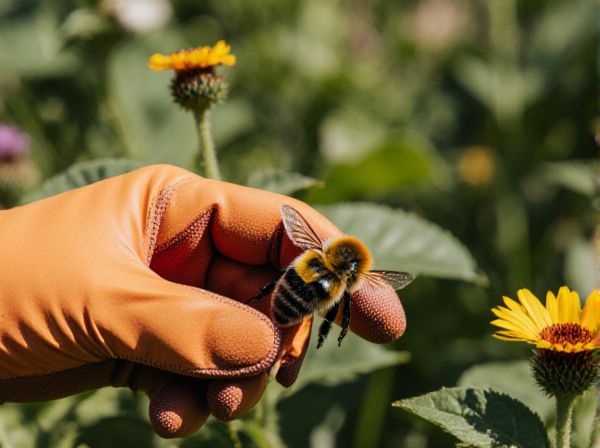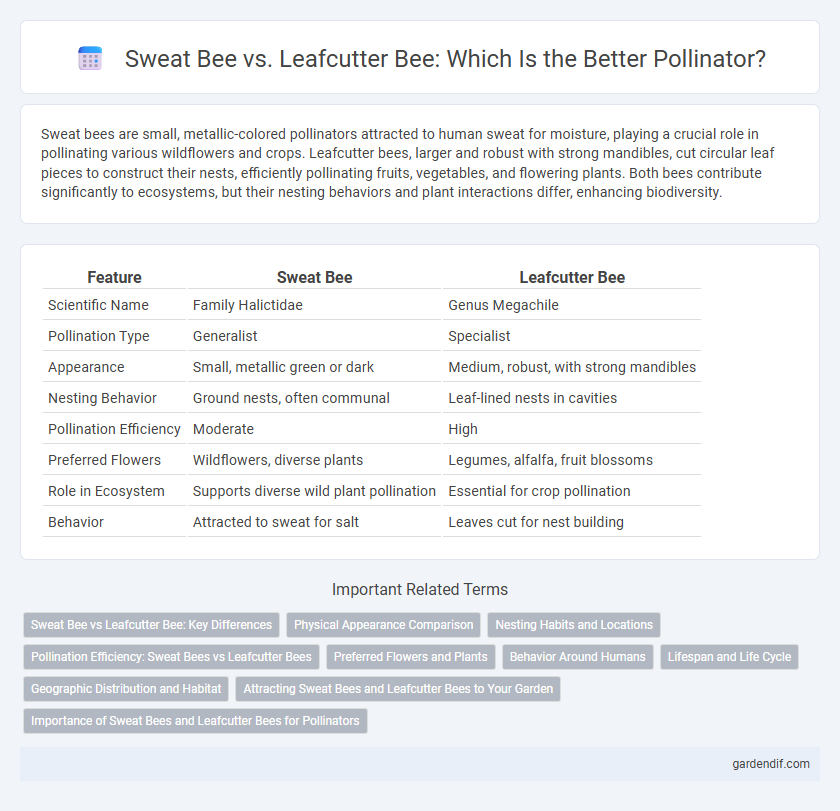
Sweat Bee vs Leafcutter Bee Illustration
Sweat bees are small, metallic-colored pollinators attracted to human sweat for moisture, playing a crucial role in pollinating various wildflowers and crops. Leafcutter bees, larger and robust with strong mandibles, cut circular leaf pieces to construct their nests, efficiently pollinating fruits, vegetables, and flowering plants. Both bees contribute significantly to ecosystems, but their nesting behaviors and plant interactions differ, enhancing biodiversity.
Table of Comparison
| Feature | Sweat Bee | Leafcutter Bee |
|---|---|---|
| Scientific Name | Family Halictidae | Genus Megachile |
| Pollination Type | Generalist | Specialist |
| Appearance | Small, metallic green or dark | Medium, robust, with strong mandibles |
| Nesting Behavior | Ground nests, often communal | Leaf-lined nests in cavities |
| Pollination Efficiency | Moderate | High |
| Preferred Flowers | Wildflowers, diverse plants | Legumes, alfalfa, fruit blossoms |
| Role in Ecosystem | Supports diverse wild plant pollination | Essential for crop pollination |
| Behavior | Attracted to sweat for salt | Leaves cut for nest building |
Sweat Bee vs Leafcutter Bee: Key Differences
Sweat bees (Halictidae) are small, metallic-colored bees attracted to human sweat for salts, while leafcutter bees (Megachilidae) are larger and known for cutting leaves to build their nests. Sweat bees typically nest in the ground, whereas leafcutter bees create solitary nests in hollow stems or wood cavities. Both are essential pollinators, but their nesting behaviors and physical characteristics distinguish their ecological roles.
Physical Appearance Comparison
Sweat bees are typically small, slender, and metallic green or blue with a shiny exoskeleton, while leafcutter bees are larger, robust, and often covered with dense hairs, especially on their abdomen. Sweat bees have more delicate wings and a less furry body compared to the leafcutter bee's stout, hairy appearance. The distinct physical traits of sweat bees facilitate their attraction to human sweat for moisture, whereas leafcutter bees are adapted for cutting leaves and carrying pollen with specialized abdominal hairs.
Nesting Habits and Locations
Sweat bees typically nest in underground burrows, favoring bare or sparsely vegetated soil in sunny locations, while leafcutter bees construct nests in pre-existing cavities such as hollow stems or wood, lining them with carefully cut leaf pieces. Sweat bees' solitary nesting habits contrast with leafcutter bees' meticulous use of leaf material to create brood cells, optimizing offspring protection. Understanding these distinct nesting behaviors is crucial for supporting pollinator habitats effectively.
Pollination Efficiency: Sweat Bees vs Leafcutter Bees
Sweat bees exhibit high pollination efficiency due to their frequent flower visits and preference for a wide range of plant species, enhancing cross-pollination. Leafcutter bees contribute significantly by carrying large pollen loads on their abdominal scopa, ensuring effective pollen transfer on targeted crops like alfalfa. These differences highlight sweat bees' versatility and leafcutter bees' specialization in agricultural pollination.
Preferred Flowers and Plants
Sweat bees primarily forage on a wide range of native wildflowers and legumes, favoring plants like goldenrod, asters, and clover due to their abundant nectar and pollen. Leafcutter bees show a preference for alfalfa, roses, and sunflowers, utilizing their strong mandibles to cut leaves for nesting material while foraging on these flowering plants. Both bees play crucial roles in pollination but differ in floral preferences aligned with their ecological niches.
Behavior Around Humans
Sweat bees, attracted to human perspiration, often land on skin to collect salt, showing a generally non-aggressive behavior unless provoked. Leafcutter bees rarely interact with humans directly, focusing their activity on cutting leaves to build nests rather than seeking out people. Both species play crucial roles in pollination but differ significantly in their behavioral responses to human presence.
Lifespan and Life Cycle
Sweat bees typically have a lifespan of a few weeks to a couple of months, with their life cycle involving egg, larva, pupa, and adult stages completed within a single season. Leafcutter bees generally live longer, up to several months, undergoing a similar metamorphosis but with solitary nesting habits that include creating brood cells lined with leaf pieces. Both species play crucial roles in pollination, but their distinct life cycle durations and nesting behaviors impact their seasonal activity and ecological contributions.
Geographic Distribution and Habitat
Sweat bees (Halictidae) predominantly inhabit temperate and tropical regions, thriving in diverse habitats such as meadows, gardens, and forest edges across North and South America, Europe, and parts of Asia. Leafcutter bees (Megachilidae) are mostly found in North America, Europe, and parts of Asia, preferring habitats with abundant floral resources and suitable nesting sites like hollow stems and wood cavities. Both bee types contribute significantly to pollination but exhibit distinct geographic ranges and nesting preferences influenced by climate and vegetation.
Attracting Sweat Bees and Leafcutter Bees to Your Garden
Planting native wildflowers and providing open, sunny soil patches are effective strategies for attracting sweat bees, which prefer moist, bare ground for nesting. Leafcutter bees are drawn to gardens with abundant flowering plants like alfalfa, asters, and roses, as well as nesting sites such as pre-drilled wooden blocks or hollow stems. Offering diverse floral resources throughout the growing season enhances pollination by supporting both sweat bee and leafcutter bee populations.
Importance of Sweat Bees and Leafcutter Bees for Pollinators
Sweat bees (Halictidae) and leafcutter bees (Megachilidae) play crucial roles in pollination, significantly enhancing biodiversity and crop yield. Sweat bees, attracted to human sweat for moisture, are efficient pollinators for wildflowers and certain crops due to their broad foraging range and frequent flower visits. Leafcutter bees contribute by cutting leaf pieces to build nests, their strong pollination effectiveness supports agricultural crops like alfalfa, making them vital for food production and ecosystem health.
Sweat Bee vs Leafcutter Bee Infographic

 gardendif.com
gardendif.com